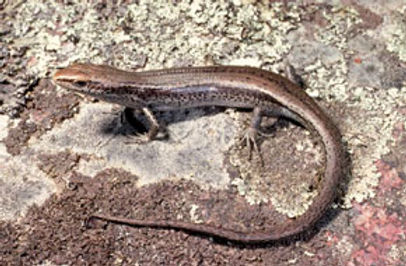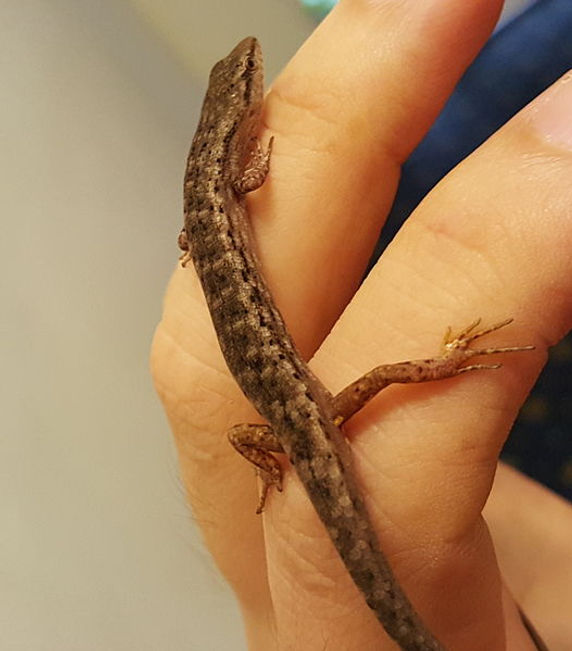From Wikipedia, the free encyclopedia :
The southern grass skink (Pseudemoia entrecasteauxii ) is a species of skink endemic to Australia, where it is found in the south-east of the continent, as well as in Tasmania and the islands of Bass Strait. Although it occurs in a variety of habitats, it is most commonly found in open grassy woodlands.
Southern grass skinks have a lifespan of about 5 or 6 years. They grow up to 7.5 cm (3.0 in) in length (not including the tail). Male skinks change colouration during the breeding season.
41- Proablepharus genus :
Proablepharus is a genus of skinks endemic to Australia.
Species :
-Proablepharus barrylyoni Couper et al., 2010
-Proablepharus kinghorni (Copland, 1947) – Kinghorn's snake-eyed skink[3]
-Proablepharus naranjicaudus Greer, Fisher & Horner, 2004
-Proablepharus reginae (Glauert, 1960)
-Proablepharus tenuis (Broom, 1896)
For the external links , refrences click here to read the full wikipedia article
- Proablepharus tenuis :
Examples :
This species still new and not available yet in the market




Proablepharus tenuis is a species of lizards of the family of Scincidae
Distribution :
This species is endemic to Australia . It is found in Western Australia , the Northern Territory and Queensland .
Protablepharus tenuis
Classification according to ReptileDB
ReignAnimalia
BranchChordata
Sub-embryo.Vertebrata
ClassReptilia
SubclassLepidosauria
OrderSquamata
Sub-OrderSauria
InfraorderScincomorpha
FamilyScincidae
SubfamilyEugongylinae
KindProteinpharus
Binomial name :
Proablepharus tenuis
( Broom , 1896 )
Synonyms:
-
Ablepharus tenuis Broom 1896
-
Ablepharus broomensis Lönnberg & Anderson, 1913
-
Proablepharus broomensis (Lönnberg & Anderson, 1913)
-
Ablepharis davisi Copland, 1952
-
Proablepharus davisi (Copland, 1952)
Examples :
This species still new and not available yet in the market
For the external links , refrences click here to read the full wikipedia article
Other Websites :
- reptile-database.reptarium.cz/species?genus=Proablepharus&species=tenuis
- www.arod.com.au/arod/reptilia/Squamata/Scincidae/Proablepharus/tenuis
- bie.ala.org.au/species/urn:lsid:biodiversity.org.au:afd.taxon:a0b0d5fc-d31d-4e6d-b183-0f10ec21134d
- Proablepharus kinghorni :


Other websites :
- reptile-database.reptarium.cz/species?genus=Proablepharus&species=kinghorni
- www.arod.com.au/arod/reptilia/Squamata/Scincidae/Proablepharus/kinghorni
- wetlandinfo.ehp.qld.gov.au/wetlands/ecology/components/species/?proablepharus-kinghorni
42- Pseudemoia genus :
Pseudemoia is a genus of skinks native to southeastern Australia. For similar skinks see genera Bassiana, Lampropholis, and Niveoscincus.
Reproduction :
At least in P. entrecasteauxii, P. pagenstecheri, and P. spenceri, a placenta-like structure is formed during pregnancy to pass nutrients to the developing offspring.[2] Similar mammal-like adaptations also occur in the skink genera Chalcides, Eumecia, Mabuya, Niveoscincus, and Trachylepis.[3]
Species :
Six species are recognized.
-
Pseudemoia baudini (A.M.C. Duméril and Bibron, 1839) -- Great Bight cool-skink, Baudin’s skink,[6] Bight Coast skink
-
Pseudemoia cryodroma Hutchinson & Donnellan, 1992 -- alpine bog skink
-
Pseudemoia entrecasteauxii (Kuhl, 1839) -- southern grass skink, tussock cool-skink, tussock skink, Entrecasteaux's skink
-
Pseudemoia pagenstecheri (Lindholm, 1901) -- southern grass tussock skink, southern tussock grass skink
-
Pseudemoia rawlinsoni (Hutchinson & Donnellan, 1988) -- Rawlinson's window-eyed skink, glossy grass skink
-
Pseudemoia spenceri (Lucas & Frost, 1894) -- trunk-climbing cool-skink
- The southern grass skink (Pseudemoia entrecasteauxii )
Examples :
This species still new and not available yet in the market
For the external links , refrences click here to read the full wikipedia article


Southern grass skink
Scientific classification :
Kingdom:Animalia
Phylum:Chordata
Subphylum:Vertebrata
Class:Reptilia
Order:Squamata
Suborder:Sauria / Lacertilia
Infraorder:Scincomorpha
Family:Scincidae
Subfamily:Eugongylinae[1]
Genus:Pseudemoia
Species:P. entrecasteauxii
Binomial name :
Pseudemoia entrecasteauxii
(A.M.C. Duméril and Bibron, 1839)
Synonyms :
-
Lygosoma entrecasteauxiiA.M.C. Duméril & Bibron, 1839
-
Leilopisma entrecasteauxi— Greer, 1974
-
Claireascincus entrecasteauxii— Wells & Wellington, 1985
-
Pseudemoia entrecasteauxii— Hutchinson et al., 1990
-
Niveoscincus entrecasteauxii— Bauer et al., 1995[1]
Etymology :
The specific name, entrecasteauxii, is in honor off French naval officer and explorer Antoine Bruni d'Entrecasteaux.[4]
Reproductive biology :
The southern grass skink has become a model species for reproductive biology in reptiles because it gives birth to live young and exhibits non-invasive epitheliochorial placentation. Unlike the majority of live bearing reptiles, Pseudemoia develop complex placentae, which provide a substantial amount of nutrients to the embryo through pregnancy.[5] Pregnancy in squamates is supported by the evolution of a novel state of gene regulation.[6] The amount of nutrients provided is dependent on the amount of food females consume during pregnancy, and, unlike other live-bearing reptiles, scarcity of food during pregnancy can cause developmental failure. When food is limiting, females will also cannibalize their offspring. Together, these results suggest that placental nutrient transport may only be a successful mode of reproduction if food is abundant throughout pregnancy, which may limit its opportunities to evolve in some reptiles.[7]Lipid transport in this species
most likely occurs through the yolk sac placenta and is facilitated in part by the production of the protein lipoprotein lipase.[8] The first observation of an extra-uterine pregnancy in a reptile was found in this species.[9] The extra-uterine embryo did not invade maternal tissue, suggesting fundamental differences between the nature and evolution of placentation in southern grass skinks and eutherian mammals.

Distribution of the southern grass skink
For the external links , refrences click here to read the full wikipedia article
Other websites :
- reptile-database.reptarium.cz/species?genus=Pseudemoia&species=entrecasteauxii
- www.parks.tas.gov.au/indeX.aspX?base=5421
- bie.ala.org.au/species/urn:lsid:biodiversity.org.au:afd.taxon:52f2912c-7d29-48f2-b385-10025c244070
43- Papuascincus genus :
Papuascincus is a genus of skinks endemic to New Guinea.[2]
Species :
The following three species are recognized as being valid:
-
Papuascincus morokanus (Parker, 1936)
-
Papuascincus phaeodes (T. Vogt, 1932)
-
Papuascincus stanleyanus (Boulenger, 1897)
Nota bene: A binomial authority in parentheses indicates that the species was originally described in a genus other than Papuascincus.
Papuascincus buergersi (T. Vogt, 1932) is a synonym of Emoia atrocostata (Lesson, 1830).
- Papuascincus morokanus :
For the external links , refrences click here to read the full wikipedia article
Examples :
This species still new and not available yet in the market



Other websites :
- www.iucnredlist.org/details/42485051/0
- reptile-database.reptarium.cz/species?genus=Papuascincus&species=morokanus
- www.terrariedjur.se/?page=info&sub=species&speciegroup=20&specie=13336
44- Saiphos genus :
Saiphos is a monotypic genus of skinks. "Siaphos" tridigitus, initially placed here, is now reassigned to the "wastebin taxon" Sphenomorphus pending a review of that assemblage.
Saiphos
Scientific classification
Kingdom:Animalia
Phylum:Chordata
Class:Reptilia
Order:Squamata
Family:Scincidae
Genus:Saiphos
J.E. Gray, 1831[verification needed]
Species:S. equalis
Binomial name
Saiphos equalis
(J.E. Gray, 1825)
Synonyms
Genus-level:
-
SiaphosJ.E. Gray, 1839 (unjustified emendation)

Distribution of the Three-toed Skink
Video :
For the external links , refrences click here to read the full wikipedia article
Snake with legs or a lizard?
For the external links , refrences click here to read the full wikipedia article
Photos :




Other websites :
- www.wherelightmeetsdark.com/index.php?module=pagemaster&PAGE_id=40&PAGE_user_op=view_page
- reptile-database.reptarium.cz/species?genus=Saiphos&species=equalis
- bie.ala.org.au/species/urn:lsid:biodiversity.org.au:afd.taxon:3d936f81-5eb9-4175-9d55-472b0c43b011
- www.arod.com.au/arod/reptilia/Squamata/Scincidae/Saiphos/equalis
45- Saproscincus genus :
Saproscincus is a genus of skinks native to Australia, sometimes referred to as shade skinks. It contains the following species:
Species :
-
Saproscincus basiliscus (Ingram & Rawlinson, 1981)
-
Saproscincus challengeri (Boulenger, 1887)
-
Saproscincus czechurai (Ingram & Rawlinson, 1981)
-
Saproscincus eungellensis Sadlier et al., 2005
-
Saproscincus hannahae Couper & Keim, 1998
-
Saproscincus lewisi Couper & Keim, 1998
-
Saproscincus mustelinus (O'Shaughnessy, 1874)
-
Saproscincus oriarius Sadlier, 1998
-
Saproscincus rosei Wells & Wellington, 1985
-
Saproscincus saltus Hoskin, 2013
-
Saproscincus spectabilis (De Vis, 1888)
-
Saproscincus tetradactylus (Greer & Kluge, 1980)
Nota bene: A binomial authority in parentheses indicates that the species was originally described in a genus other than Saproscincus.

Saproscincus
Saproscincus mustelinus,
found climbing in a small shrub.
Scientific classification
Kingdom:Animalia
Phylum:Chordata
Subphylum:Vertebrata
Class:Reptilia
Order:Squamata
Suborder:Sauria/Lacertilia
Infraorder:Scincomorpha
Family:Scincidae
Subfamily:Eugongylinae
Genus:Saproscincus
Wells & Wellington, 1983
- Saproscincus mustelinus :
Saproscincus mustelinus,
found climbing in a small shrub.




From Wikipedia, the free encyclopedia
Saproscincus mustelinus,[2] commonly known as the southern weasel skink, is a small species of skink which is endemic to Australia.
Behavior :
S. mustelinus is usually nocturnal, but is most active in the evening and warm mornings.
Diet :
S. mustelinus hunts and feeds on small insects and other small invertebrates.
Description :
The southern weasel skink is around 45 mm (1.8 in) from snout to vent, is covered in iridescent reddish brown (fine) scales, and has several distinctive white marks behind and below the eye.[3]
Defensive behavior :
If frightened this skink has the ability to lose its tail as a defence mechanism; the tail lies on the ground twitching, distracting the predator so the skink can escape.[4][5][6]
Habitat :
[7] The southern weasel skink tends to utilize existing vegetation and fallen timber for shelter.
Geographic range
The southern weasel skink's distribution forms a coastal strip from south Victoria to southern Queensland.[8] [9]
Reproduction :
Females lay up to four eggs per clutch in a communal nest. The nests are normally a dugout, an underground burrow, which contain the eggs of numerous females.[10] Laying normally occurs between spring and late summer.
Saproscincus mustelinus
Scientific classification :
Kingdom:Animalia
Phylum:Chordata
Subphylum:Vertebrata
Class:Reptilia (paraphyletic)
Subclass:Diapsida
Order:Squamata
Suborder:Sauria
Infraorder:Scincomorpha
Family:Scincidae
Subfamily:Eugongylinae
Genus:Saproscincus
Species:S. mustelinus
Binomial name:
Saproscincus mustelinus
(O'Shaghnessy, 1874)
Synonyms :
-
Mocoa mustelinaO'Shaughnessy, 1874
-
Lygosoma mustelinum— M.A. Smith, 1937
-
Lamropholis mustelina— Greer, 1974
-
Saproscincus mustelinus— Wells & Wellington, 1983[1]



For the external links , refrences click here to read the full wikipedia article
Other websites :
- www.ausemade.com.au/fauna-flora/fauna/reptilia
- reptile-database.reptarium.cz/species?genus=Saproscincus&species=mustelinus
- www.arod.com.au/arod/reptilia/Squamata/Scincidae/Saproscincus/mustelinus
Video :
D&D's Fast Facts - The Weasel Skink.
- Saproscincus spectabilis :




From Wikipedia, the free encyclopedia
Saproscinus spectabilis known as the pale-lipped shade skink is a small lizard found in Queensland and New South Wales, Australia.[2] The habitat is cool, shaded gullies where it feeds on small insects. It may be seen on sunny rocky outcrops within gullies. Ground cover and rocky cracks are required to avoid predation from birds such as the kookaburra and pied currawong.

Scientific classification :
Kingdom:Animalia
Phylum:Chordata
Class:Reptilia
Order:Squamata
Family:Scincidae
Genus:Saproscincus
Species:S. spectabilis
Binomial name:
Saproscincus spectabilis
(De Vis, 1888)
Synonyms [1]:
Saproscincus galli Wells & Wellington, 1985
For the external links , refrences click here to read the full wikipedia article
Saproscincus spectabilis
Other websites :
- www.arod.com.au/arod/reptilia/Squamata/Scincidae/Saproscincus/spectabilis
- reptile-database.reptarium.cz/species?genus=Saproscincus&species=spectabilis
Please select or follow below :
SKINKS SPECIES : Blue - tongued skinks : Part 1 - 2 - 3 - 4 - 5 - 6 - 7
Five - Lined Skinks : Part 1 - 2
Other Skinks : ASIAN & AFRICAN skinks : Part 1 2 3 4 5 6 7 8 9 10 11 12 13 14 15
Other Skinks American Part : 1 - 2 - 3
Other Skinks Australian Part : 1 2 3 4 5 6 7 8 9 10 11 12 13 14
Please select or follow below :
SKINKS SPECIES : Blue - tongued skinks : Part 1 - 2 - 3 - 4 - 5 - 6 - 7
Five - Lined Skinks : Part 1 - 2
Other Skinks : ASIAN & AFRICAN skinks : Part 1 2 3 4 5 6 7 8 9 10 11 12 13 14 15
Other Skinks American Part : 1 - 2 - 3
Other Skinks Australian Part : 1 2 3 4 5 6 7 8 9 10 11 12 13 14